It’s no secret that Labradoodles are high maintenance when it comes to their coats. We’re going to find out what’s the best brush for Labradoodle and look at some other Labradoodle grooming tools that you might need. And, of course, we’ll discuss how and how often you should brush your Doodle.
Regular brushing is an absolute must. Not just for vanity, but also for your Doodle’s health. If you don’t brush your Labradoodle regularly, knots and tangles will start to form. As a result, your Labradoodle’s coat can become matted, which in turn can cause a wide range of issues. For example, skin irritation, infections, bad smell, and discomfort.
To keep this from happening, you should regularly brush and groom your Doodle. And the sooner you start, the better. Introduce them to brushing as soon as you bring them home. Starting out young will help your Labradoodle get used to brushing. It’s also a nice way to spend some quality time together and socialize.
Regular brushing helps distribute your Doodle’s natural skin oils throughout their hair, which naturally conditions and protects their coat.
Depending on your Labradoodle’s coat type, there are a variety of reasons why you should brush them regularly. Although Labradoodles tend to shed a lot less than other dog breeds thanks to their parent Poodle, they’ve still inherited some traits from the Labrador Retriever (namely, shedding). Most likely your Doodle needs help removing the old hair, so it won’t knot and mat.
Even if your Labradoodle’s coat resembles more Poodle hair, brushing their hair often is crucial. Poodles’ curly hair is also prone to knots and tangles, so prevention is key. In other words, whatever type of hair your Labradoodle has, brush them regularly. Also, make sure to read our article on dealing with Doodle hair matting.
Tip: Labradoodle owners who suffer from dog allergies will very much benefit from regular brushing. Brushing your Doodle’s hair ensures that less dog hair, dander and saliva will get on your furniture and belongings.
Types Of Popular Labradoodle Brushes
Slicker brushes are definitely one of the most popular brush types for Doodles. Its wide base and fine, densely placed bristles help cover bigger areas of hair and work through the knots and tangles. A slicker brush is also great for deshedding. These types of brushes are also very convenient to use thanks to the handle and paddle placement.
Bristle brushes are another great Labradoodle grooming tool that many owners swear by. It’s especially gentle on your Doodle’s hair and skin. In addition, it adds a gorgeous shine to a dog’s hair.
Pin brushes look almost like your own hair brush. Pin brushes typically have polished ends or soft rubber tips on the bristles, which are gentler on Doodles’ skin. The pins are soft and help detangle knots. Pin brushes are great for a quick brushing after play-time outside. However, they’re not designed for deshedding thick undercoat hair or de-matting.
Combs are great for smaller knots and tangles that need special attention. Use the wide-tooth end of your comb to detangle bigger knots, and the fine-tooth end for smaller knots. You’ll also need a comb when dealing with sensitive and tricky areas like your Doodle’s face, eyes, ears, and paws.
What Is The Best Labradoodle Brush Type To Use?
Choosing the right type of brush for your Labradoodle largely depends on the type of coat your Doodle has. Labradoodles can have a wavy coat, curly coat, or anything that fits in between the two.
Another thing to consider is your Doodle’s hair length. If your Labradoodle sports longer hair, you should use a brush with longer bristles or pins to reach the hair from all lengths. Also, the longer your Doodle’s hair, the wider the bristles should be placed.
Even if you keep your pup’s hair on the shorter side, you should brush their hair regularly. Likewise, shorter hair requires a brush with shorter, more tightly placed bristles.
If your Labradoodle is still a puppy, we recommend you use a brush specially designed for puppies. The best brush for Labradoodle puppy would be in an appropriate size and with very soft bristles. Puppy’s skin is a lot more delicate, so it’s especially important to use gentle grooming tools.
Furthermore, puppies’ hair does change once they reach adulthood, so they will most certainly need different grooming tools when they get their adult coat.
Different Types Of Labradoodle Coats
So, the best dog brush for Labradoodle is the one that suits their hair. That’s why it’s important we understand the different types of hair Labradoodles can have and how they should be brushed.
There are three main types of Labradoodle coats:
Hair/Straight coat – this is the straight hair type on Labradoodles and might feel wiry. Typically this type of hair sheds the most and is considered the least allergy-friendly.
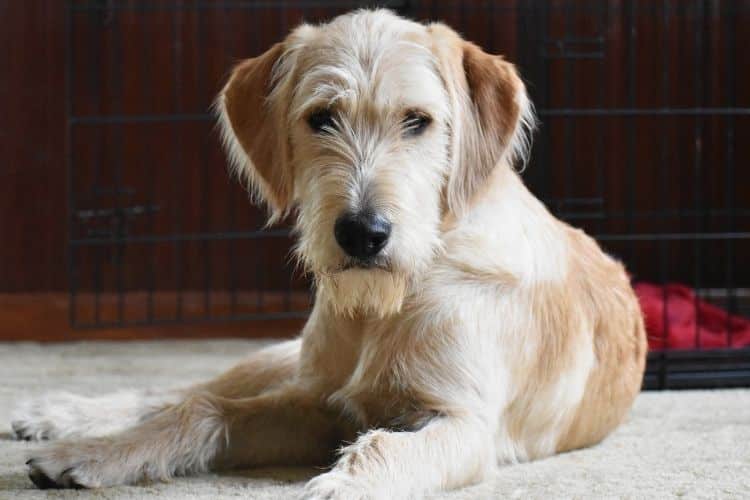
Wavy/Fleece coat – hair looks wavy and feels silky to touch. Usually it sheds very little.
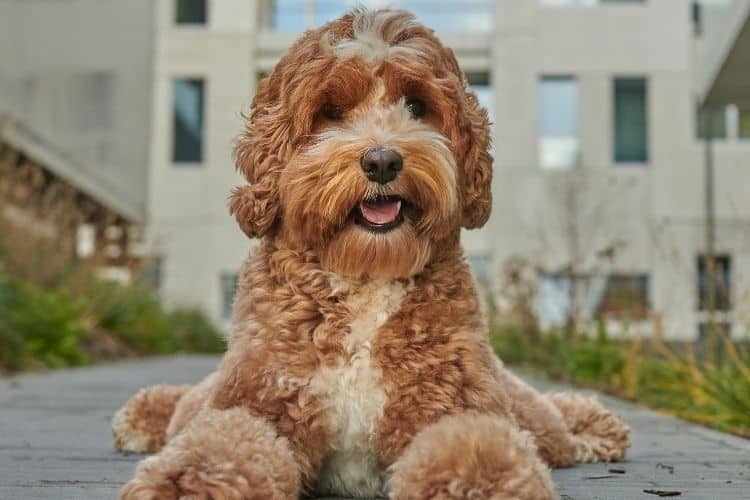
Curly/Wool coat – the Labradoodle’s hair has thick curls and a dense feel. As it’s a more Poodle-like coat, it is usually very low or non-shedding.
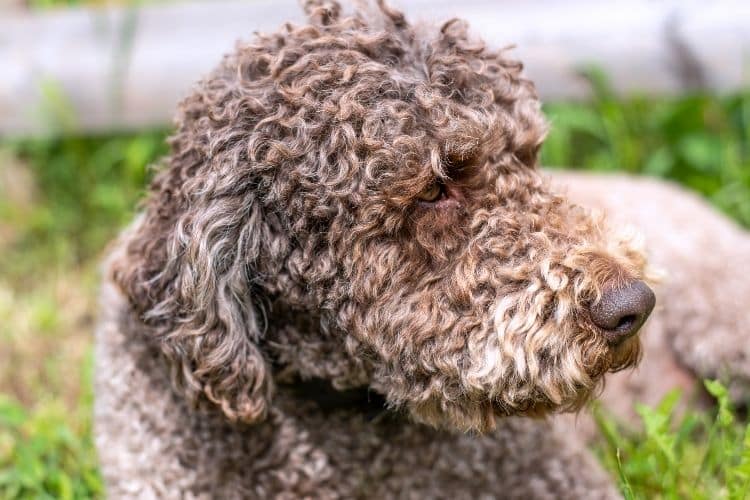
Best Brush for Labradoodle Coat Types
So now you should know what type of hair your Labradoodle has. It’s time to figure out which Labradoodle grooming tools you need.
A straight coat indicates that your Doodle has mostly inherited their coat type from the parent Labrador Retriever. As the hair coat tends to shed the most, it’s important you brush the undercoat regularly. Dogs usually need some help to remove the old hair, so it doesn’t tangle and mat. Slicker brushes are perfect for deshedding and getting into the bottom layers of your Doodle’s hair.
Thanks to the wavy, silky and soft texture, Fleece Coats are usually very easy to brush. Bristle brushes work great on both wavy and straight dog hair. Slicker and pin brushes are also suitable for fleece coats.
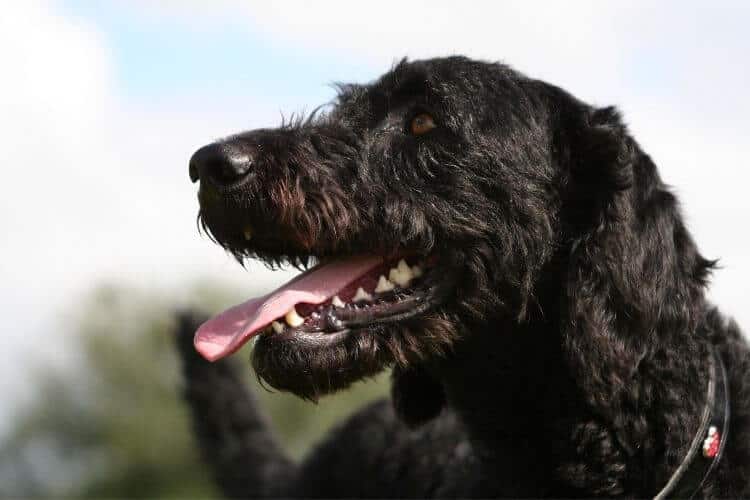
Wool Coats that are inherited from the Poodle parent typically does not shed, but it is prone to knots and matting. Because of this, a wool coat tends to need more brushing than other Labradoodle coat types. Pin brushes, slicker brushes, and combs are amazing for brushing curly hair as they gently help detangle knotted hair. Bristle Brushes, however, usually don’t work well on wool coats.
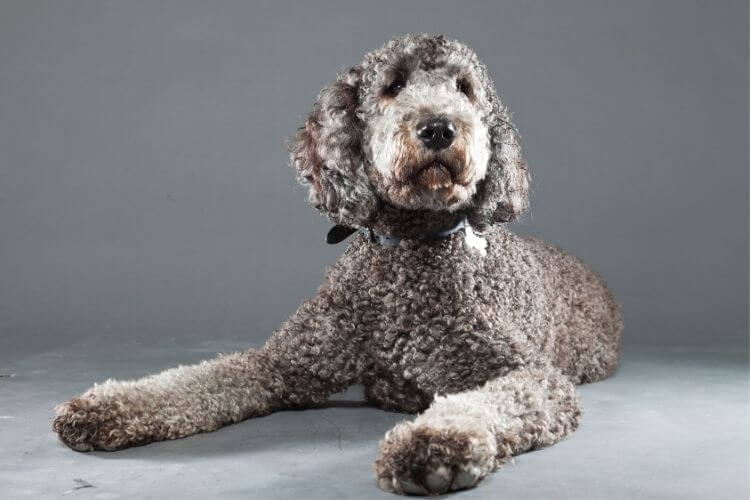
Best Brush For Labradoodles: Reviews
There are tons of different Labradoodle grooming tools on the market. Naturally, choosing the correct tools might not be the easiest task. Here are the three highest rated grooming tools that Doodle owners rave about. Also, these two brushes and a metal comb should be in every Labradoodle and Doodle owner’s grooming kit.
Chris Christensen Big G Slicker Brush
A high quality slicker brush is an absolute must when dealing with Labradoodles. The Chris Christensen Big G Slicker Brush is one of the most popular brushes for Doodles. Doodle owners say that this slicker brush gets the job done in half the time (we can agree that it certainly speeds things up!). It’s great for picking up loose undercoat hair, and the pins feel flexible and glide easily without much poking.
Even though this particular slicker brush is on the pricier side, so many Doodle owners swear by it. That’s no surprise, as it truly is a high quality and durable Labradoodle brush that lives up to the hype.
And since grooming a Labradoodle should be a regular thing, a one-time investment in a proper brush will be absolutely worth it. Of course, there are probably some good, cheaper options available. But make sure to do your research. Slicker brushes may all look the same, but they definitely may not feel or work the same.
Chris Christensen Pin Brush
Another amazing brush from Chris Christensen is the Chris Christensen Oval Pin Brush (also available in an oblong shape). The metal pins might look a bit scary at first, but the tips have been polished. So, they’re not harsh on the skin and won’t cause any harm to your Labradoodle’s skin or coat. The pins run smooth through the hair and gently massage the skin.
Not only is it a great dog brush for detangling knots, it’s also gentle while doing that. The Oval Pin Brush works great on all Labradoodle coat types. This brush is also perfect for a quick grooming session after playing outside, or for daily brushing.
Again, this is not the cheapest dog brush. However, the quality speaks for itself. As it does an amazing job while being extremely gentle, it’s certainly a very good investment for your Doodle’s health.
Metal Comb
A metal comb is a must-have for all Doodle owners. They are imperative for daily coat care, as well as the occasional line brushing session. They are typically made from steel, making them super durable and able handle even the thickest and toughest coat. Doodle owners especially need them to reach knots that can’t be seen. A high-quality metal comb will last you and your Labradoodle a lifetime.
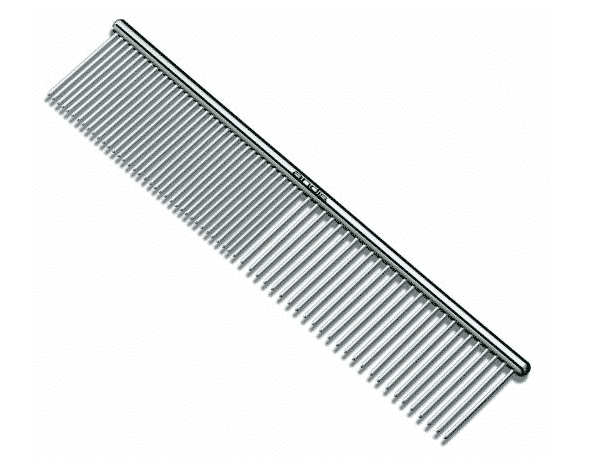
A proper metal comb for Doodles is one that has a wide-tooth and a fine-tooth end. They are amazing for detangling knots, removing loose hair, and dirt. The pins on the comb are typically soft to the touch and won’t hurt your Doodle.
The Andis Steel Comb must be one of the highest-rated combs for Doodles. However, there are plenty of other brands that carry metal dog grooming combs that are equally as high-quality.
Other Brushes as Suggestions
For Labradoodles who get scared of brushes, grooming gloves can be a safer option to get into the habit of brushing. Grooming gloves are great for removing shed hair, and also massaging and relaxing your Doodle.
In addition, Labradoodles who tend to shed a lot, might benefit from using a deshedding dog brush. However, most of the time, a slicker brush can do the job just as well.
How To Brush A Labradoodle Properly?
Choosing the correct brushes and grooming tools for your Labradoodle is crucial. But so is proper technique.
Whatever type of brush or comb you use, do not put too much pressure on your Doodle’s skin. First, try out a new, unused dog brush on your own skin and scalp to understand how it feels. Adjust the pressure and angle so it feels pleasant. Remember, your Doodle has feelings too. And always brush and comb in the same direction as your Doodle’s hair grows.
Before you start brushing larger areas on your Doodle, run your hands through their hair. If you find any tangles, gently work through them with a comb or a pin brush. Don’t use any force or pull the knots, as this can be painful for your Doodle. In fact, it will also make the knots harder to get out. Looser knots can also be brushed out with a slicker brush, as they’re great for detangling.
You can also use a detangling product to work out tougher knots and mild matting.
The best way to brush your Labradoodle is from bottom to top. Start from their feet, moving to the underbelly, genital area, and neck. Move up their body as you’ve finished brushing the previous area. If you start brushing from the top, you might make tangles worse as you move lower.
Here’s a helpful guide you can follow when brushing your Labradoodle:
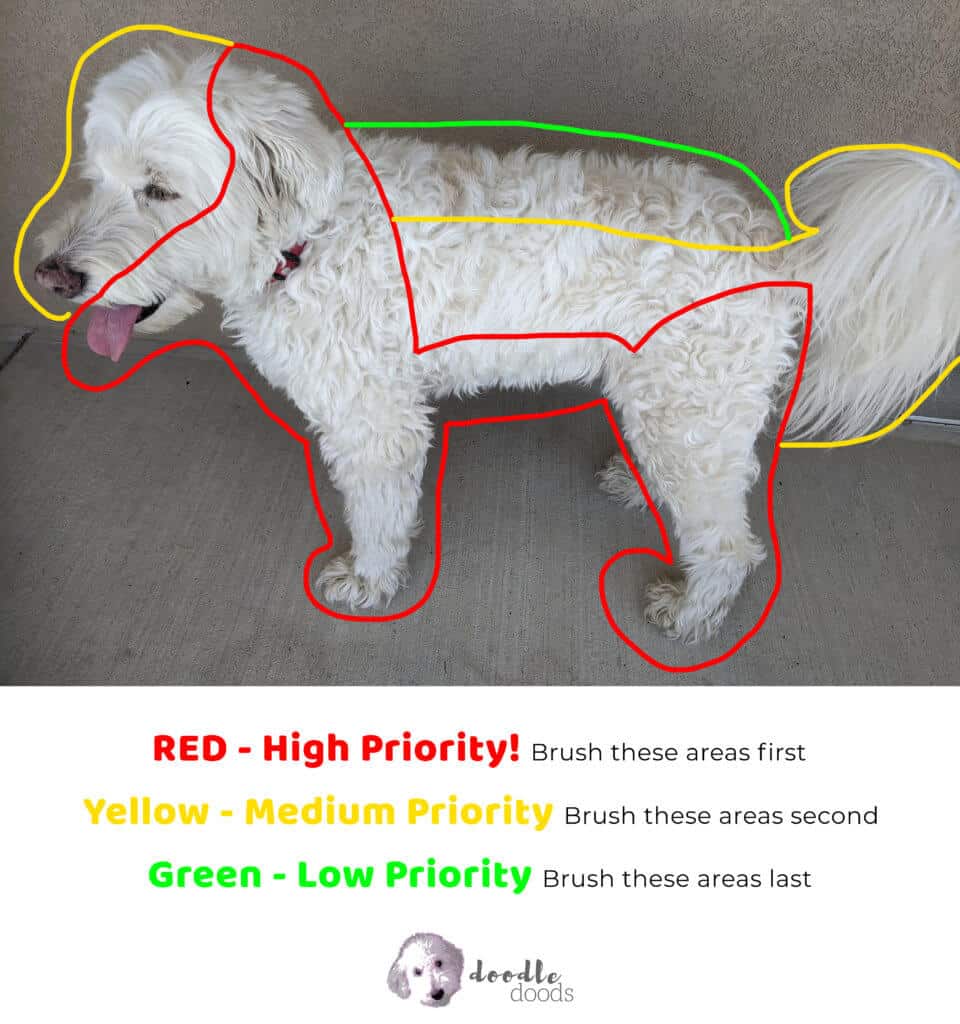
Another great technique that you can use to avoid knots and tangles is line brushing. Of course, line brushing is more time consuming, because you focus on small areas at a time. However, it’s a very effective way to prevent matting. Check out our line brushing tutorial here.
If your Labradoodle has tangles and it happens to be a bath day, use a detangling shampoo or conditioner. After that, dry the hair, and once it’s dried, you can use a slicker brush.
Don’t forget the sensitive areas like eyes, ears, underbelly, genital area, and paws. These spots should be combed with a smaller comb that can reach those delicate areas. And don’t forget their legs, neck, and fur behind the collar – these areas experience the most friction. Therefore, the hair can easily mat if not brushed regularly.
Another useful tip is to start brushing less sensitive areas first to not freak out your Doodle. It’s easier to brush most of the coat and leave the less pleasant areas for the end, or to work on over a few days.
Last, but not least. Don’t forget to praise your Doodle and make the whole brushing experience a positive one. Positive reinforcement and a treat can do wonders, and your Labradoodle might even look forward to the next brushing!
Can You Over-Brush a Labradoodle?
Regular, even daily brushing is necessary, as it plays an important role in keeping your Doodle happy and healthy. But if you don’t brush your Labradoodle correctly, it can actually cause damage.
For instance, if you put too much pressure on your Doodle’s skin with the brush, or brush a spot for too long, it can cause skin irritation and skin damage. You’ll either injure your Doodle’s skin, or the irritation might make your pup scratch his skin more causing it to become a wound.
You don’t want to make your Doodle feel uncomfortable. Over-brushing a spot or knot might not just cause irritation, but actual pain. So for the both of you to enjoy brushing, make sure you won’t hurt your dog in the process.
Another thing to keep in mind is to not bathe your Doodle too often. This can dry out their skin, as their natural protective oils will be stripped away. This, in turn, can cause further irritation and itchiness. If you add brushing too hard to the equation, you will most likely hurt your Doodle’s skin and damage their coat.
FAQs
The absolute basic grooming tools that each Labradoodle should own are a high quality slicker brush and a comb. Depending on your Doodle’s hair length and texture, you can easily choose a brush with appropriate bristles and pins. Longer hair needs longer bristles and shorter hair needs shorter bristles.
The FURminator is designed to reach the undercoat hair and remove any old hair. We recommend you use the FURminator only when there is no matting. FURminator can be a wonderful brush for Labradoodles’ coat, as it can comb through both the undercoat and topcoat. However, if your Doodle’s hair is matted, it can be too harsh.
The best way to deal with tangles and matting is prevention. Daily brushing is extremely helpful to avoid any knots. Even if you can’t brush your Labradoodle every day, try to do it every other day and most definitely after playing outside to get rid of the dirt. It’s easier to maintain your Doodle’s healthy coat than to deal with stubborn matting every other week. Also, keep in mind that curlier hair requires more regular brushing.
Start from the bottom and move your way up to the top of your Doodle’s body. First, pay attention to knots and tangles. Gently pick them with a comb or a pin brush without ripping out hair or causing your Labradoodle pain. Once you’ve cleared all the knots and tangles, move on to a bigger brush to cover larger areas of coat at a time.
To conclude, as it’s said, “with great Doodle comes great responsibility.” Brushing your Labradoodle’s hair should be a regular thing in your household. Choosing the best brushes for your Labradoodle and brushing them with proper technique will surely benefit your Doodle’s life quality.
Learn How to Stop Shavedowns For Good & Keep Matting At Bay!
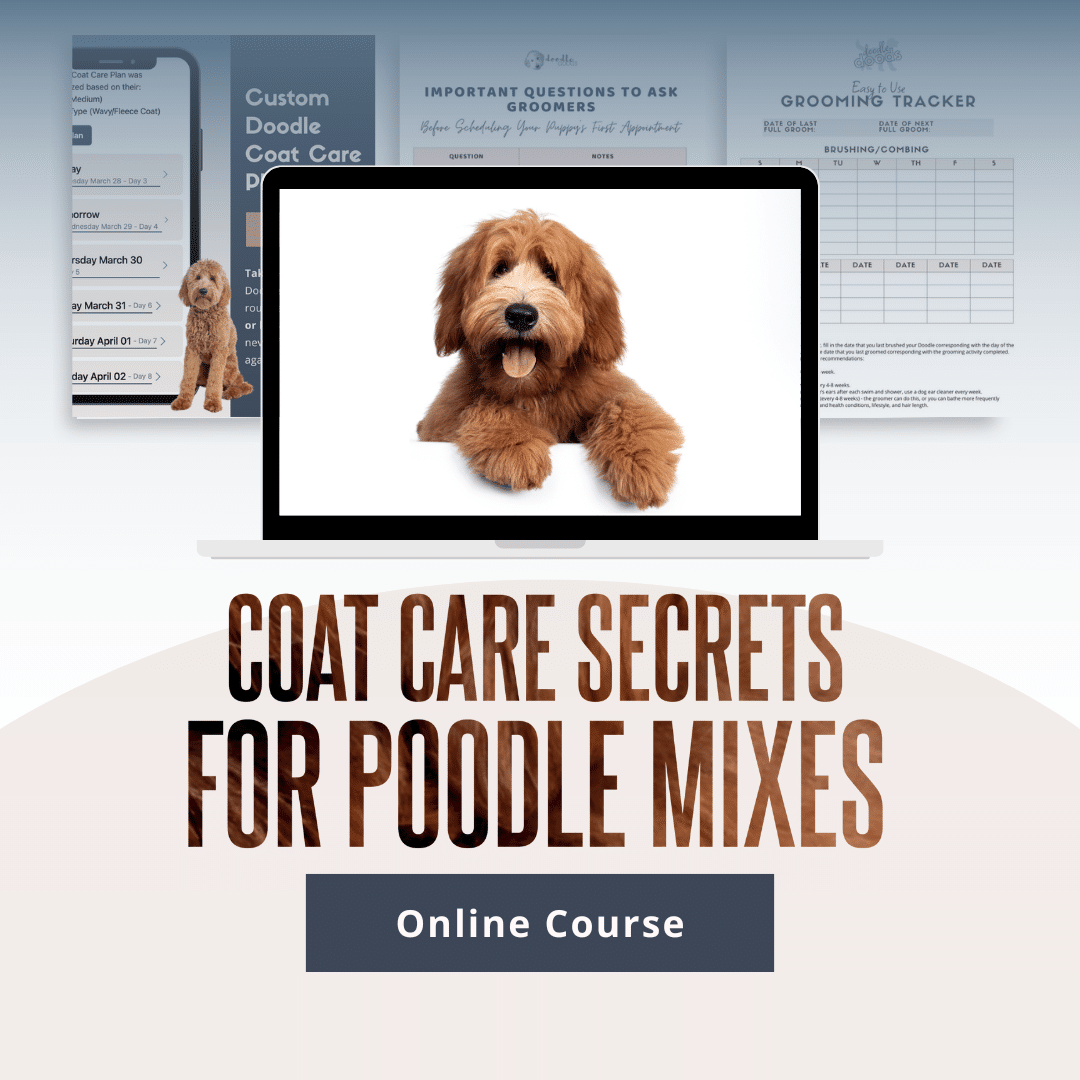
Discover the PROPER Doodle coat care routine that gets your pup to cooperate…helps you nip tangles in the bud…and gets groomers to do exactly what you want.
Plus, get $520 worth of Bonus Materials for FREE, including:- Doodle Parenthood Community and Support Group ($190 value)
- Custom Doodle Coat Care Plan Lifetime Access ($75 value)
- Easy to Use Doodle Grooming Tracker ($20 value)
- And MORE!
The information on this page is for informational purposes only. It is not intended to be a substitute for professional groomer advice. Always seek the advice of your groomer, veterinarian, or other qualified animal health provider with any questions you may have.
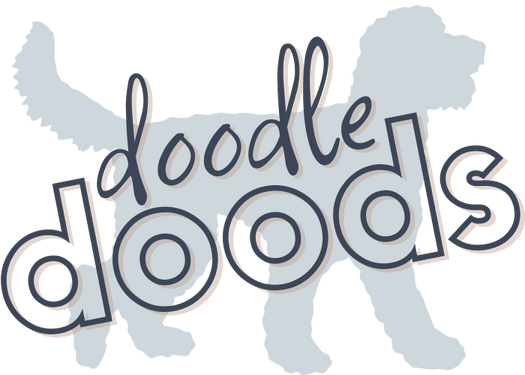

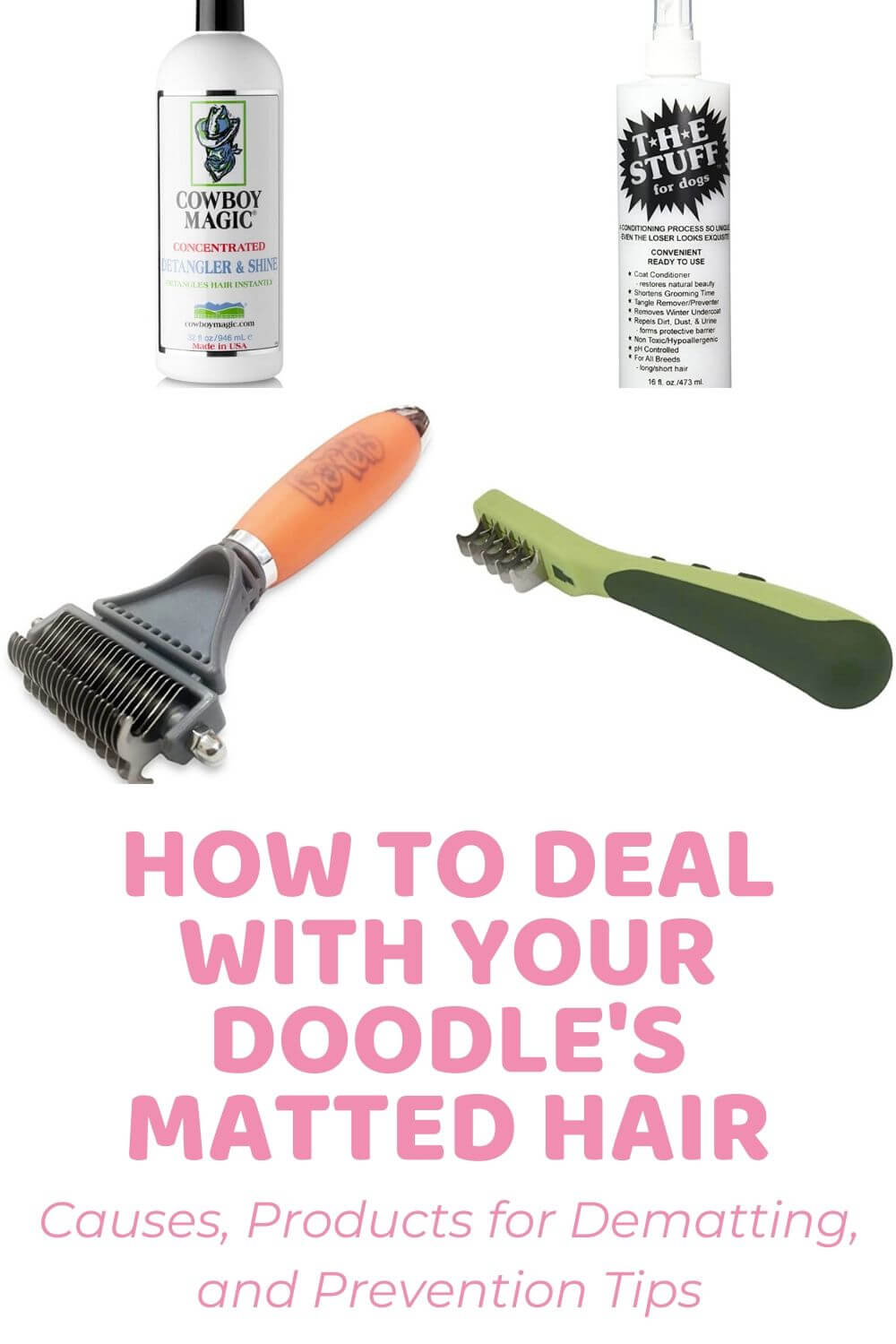
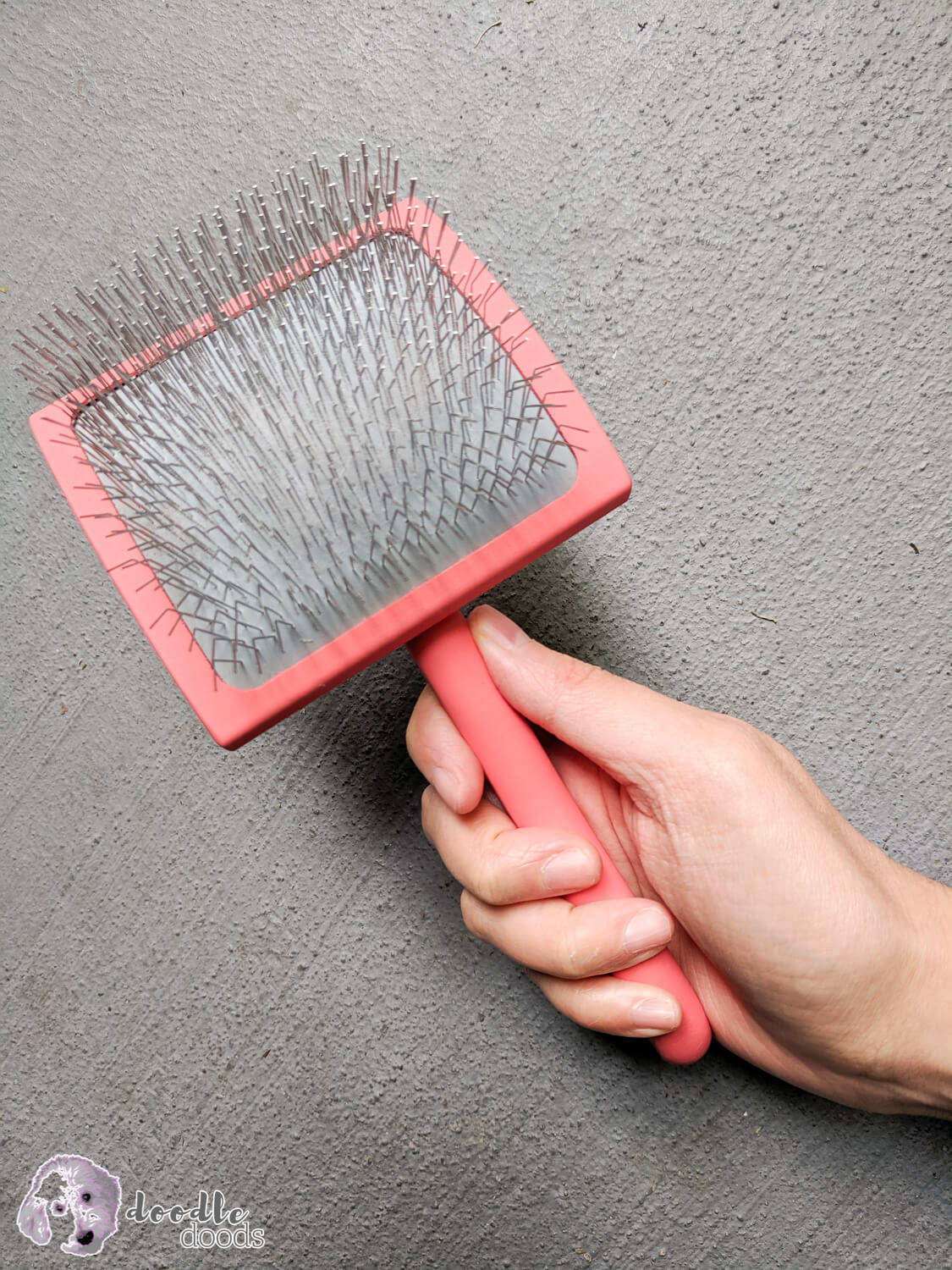

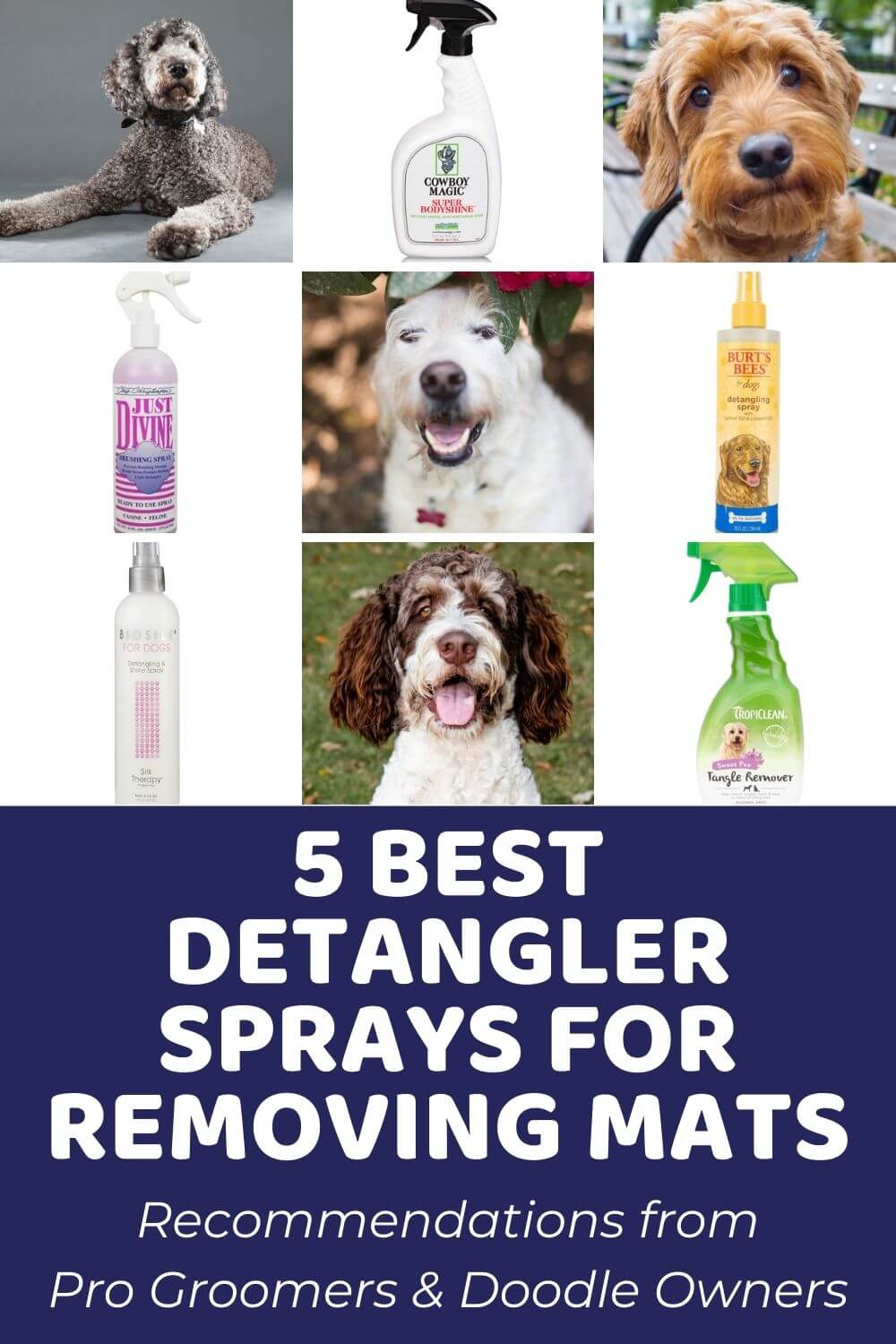
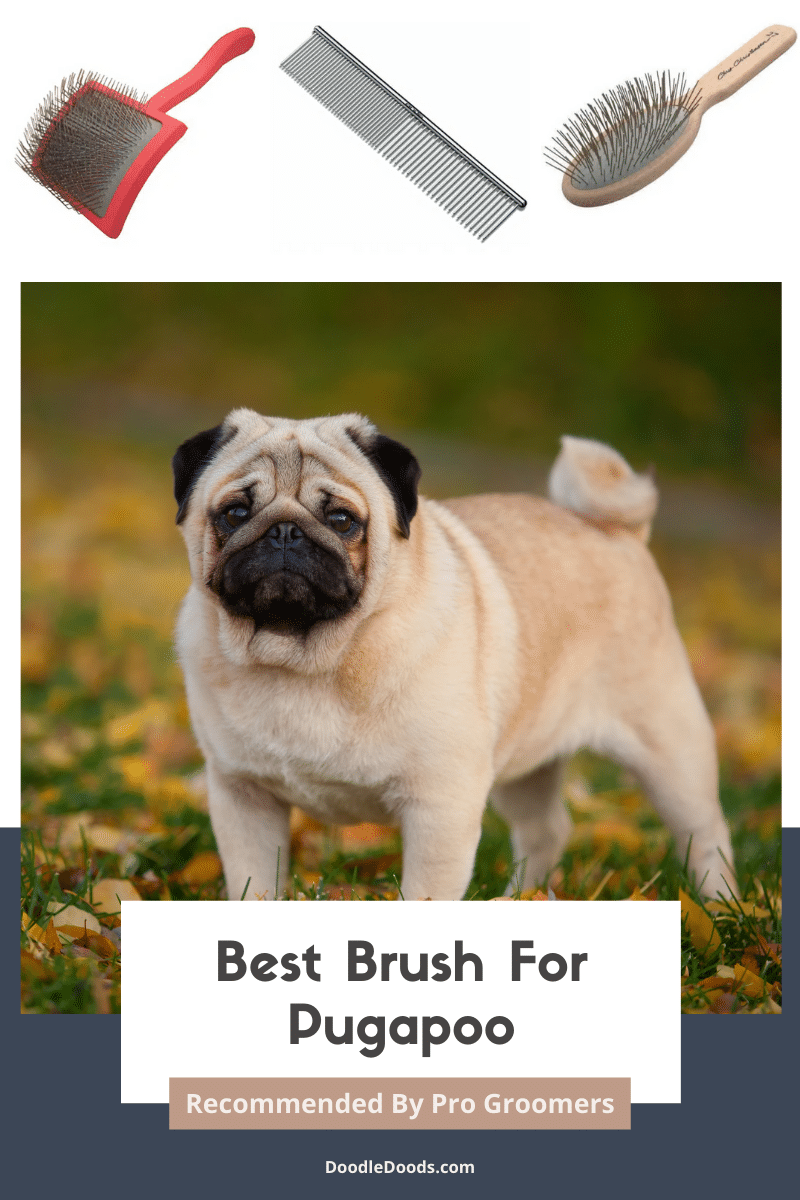
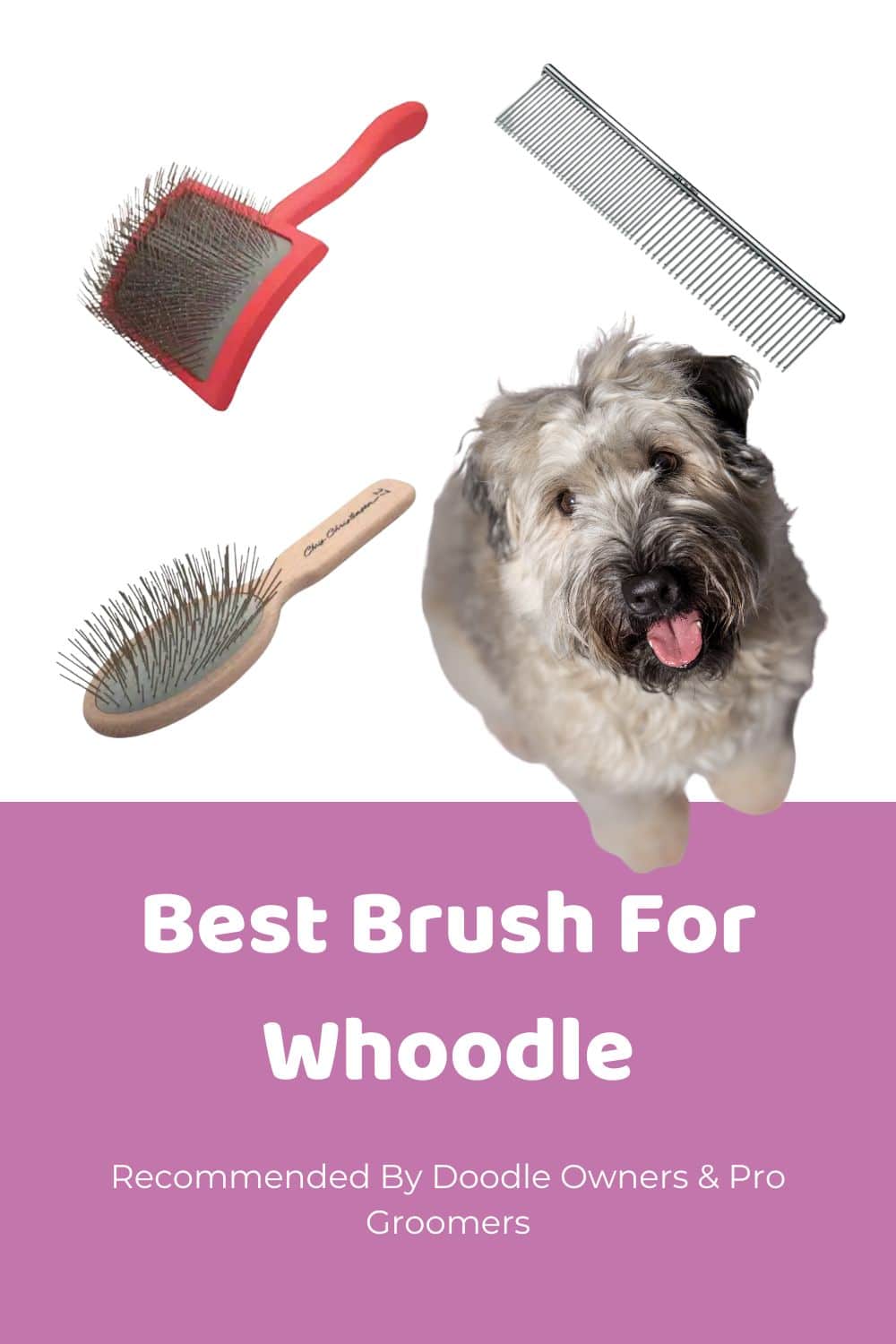
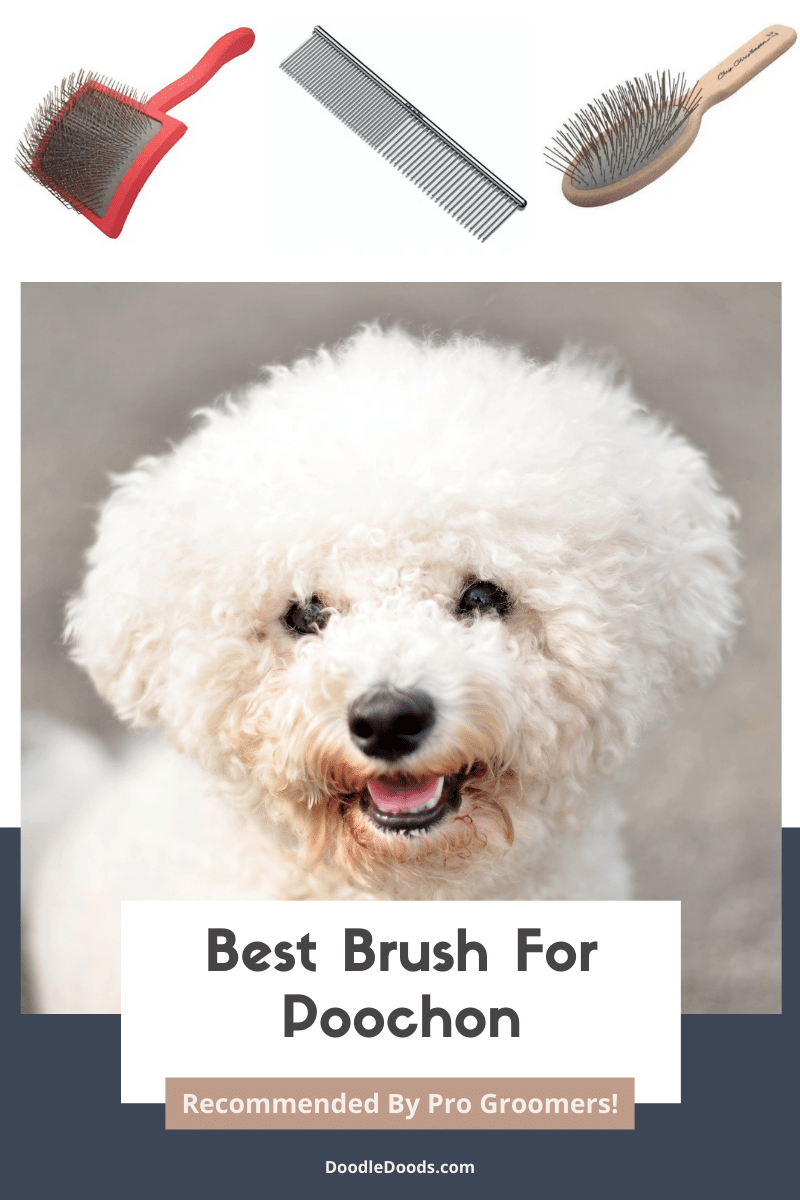
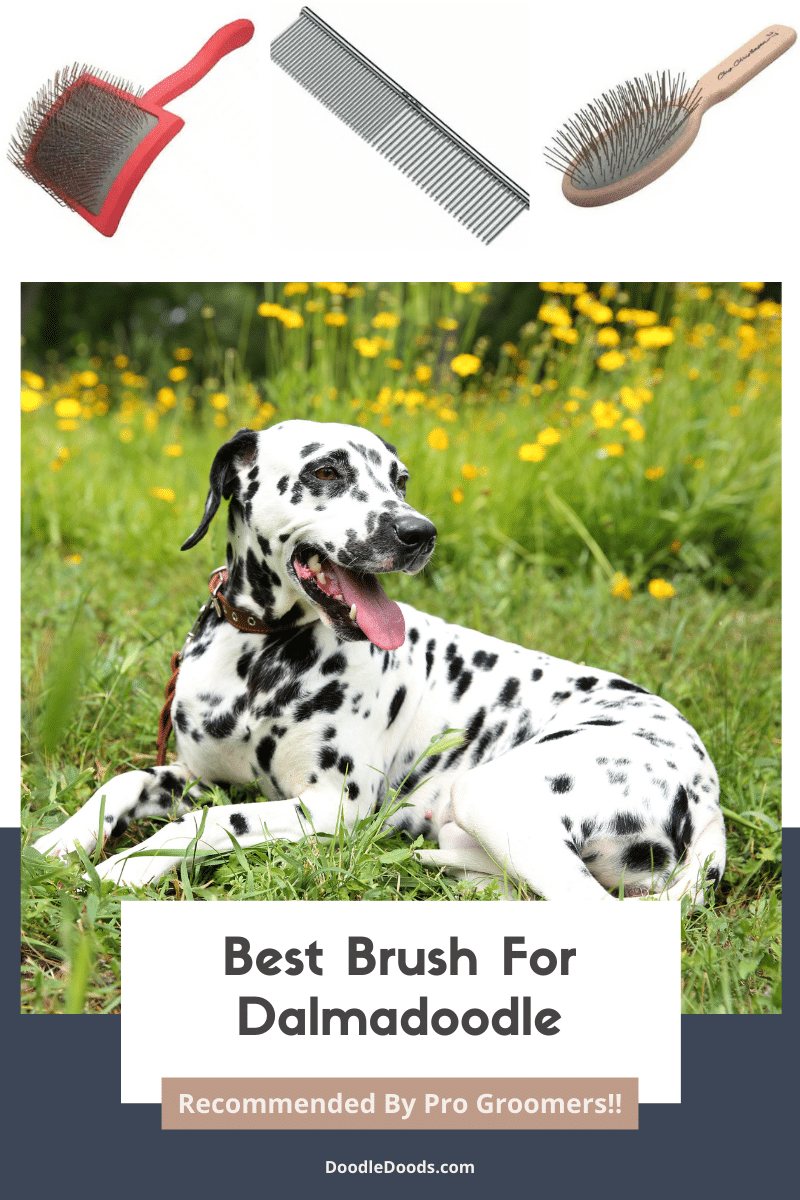

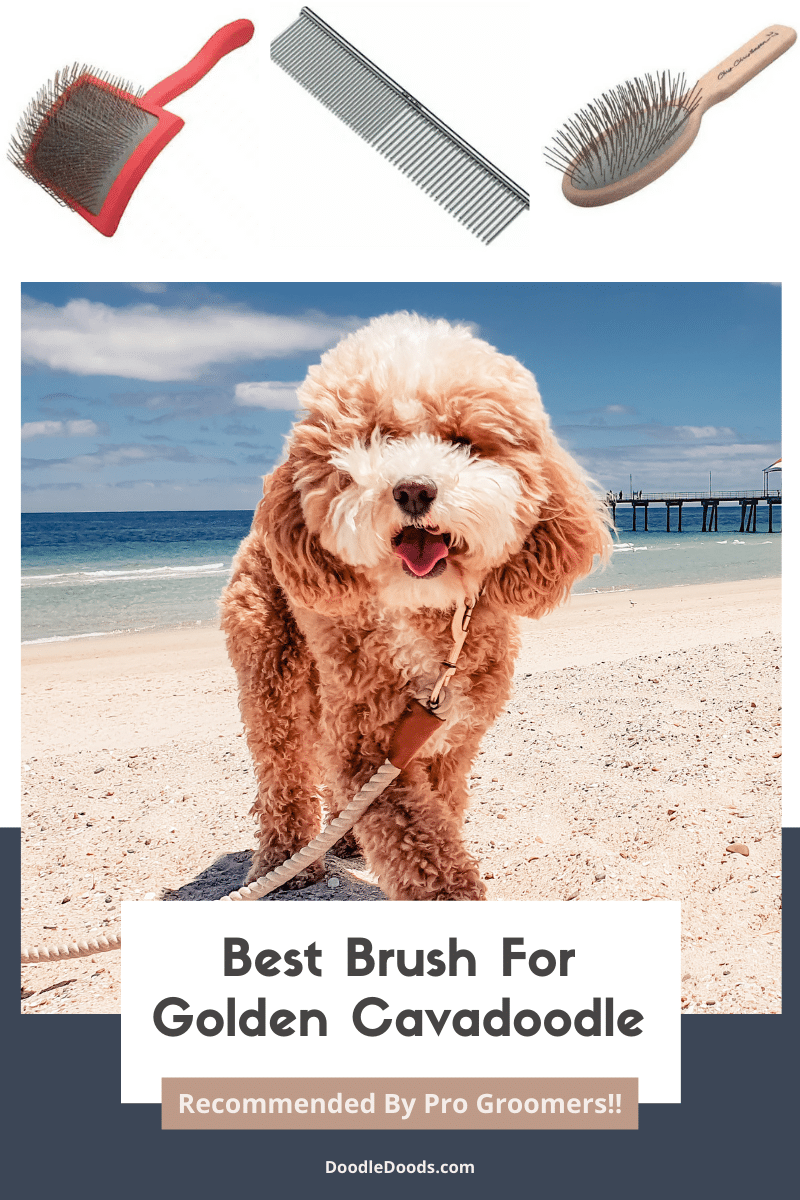
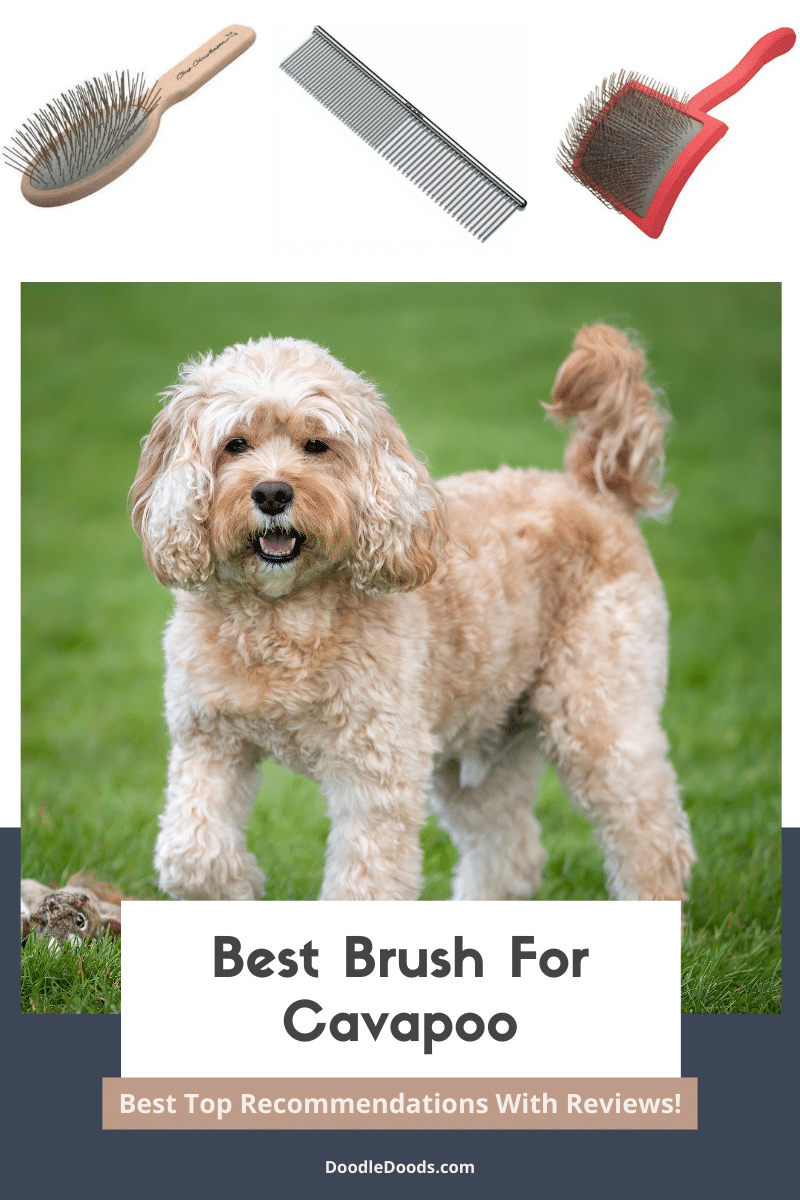
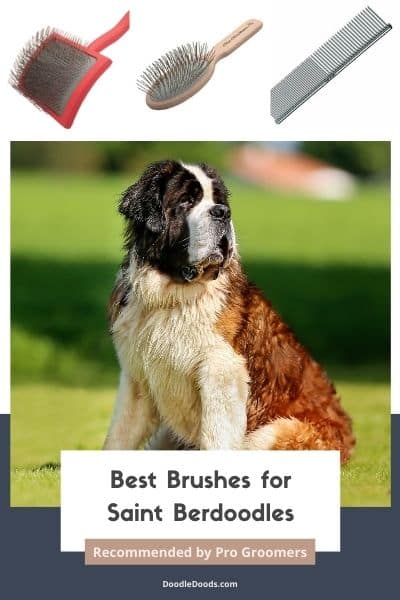
What are your favorite Labradoodle grooming tools? What is the best dog brush for Labradoodle? We’d love to hear your thoughts in the comment section!